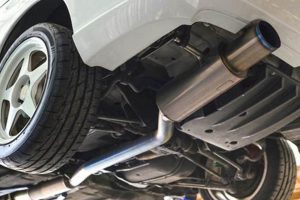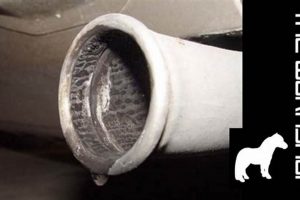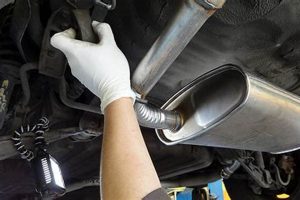A crucial component in an automotive exhaust system, this device significantly reduces the noise produced by the engine’s combustion process. It achieves this by employing a series of chambers and tubes designed to reflect and absorb sound waves. An example of its application is found in almost every gasoline-powered vehicle on the road, where it ensures that the operational sounds remain within acceptable noise pollution limits.
The significance of this element extends beyond mere noise reduction. Functioning effectively contributes to a more comfortable driving experience for both the operator and passengers. Furthermore, adherence to noise regulations, which are often enforced by law, relies heavily on the proper operation of this component. Historically, advancements in its design have paralleled the development of more powerful and efficient internal combustion engines, necessitating increasingly sophisticated sound dampening techniques.
Understanding the specific design and function of this vital piece of equipment is essential for comprehending broader aspects of automotive engineering. This exploration will further examine different types of these systems, common issues that may arise, and best practices for maintenance and repair to ensure continued optimal performance and compliance with environmental standards.
Maintenance and Longevity Tips
Proper upkeep of the exhaust system’s primary silencing component is crucial for optimal vehicle performance and noise control. The following recommendations offer guidance on extending its service life and preventing premature failure.
Tip 1: Routine Visual Inspections: Conduct regular visual examinations of the external housing for signs of rust, corrosion, or physical damage. Early detection of these issues can prevent more significant problems from developing.
Tip 2: Address Rust Promptly: If surface rust is detected, apply a rust converter or inhibitor to prevent further deterioration. This preventative measure can significantly extend the lifespan of the component.
Tip 3: Avoid Short Trips: Frequent short trips can cause excessive condensation to accumulate within the system, accelerating corrosion. Longer drives allow the system to reach operating temperature and evaporate moisture.
Tip 4: Monitor for Unusual Noises: Pay attention to any changes in exhaust sound. Rattling, hissing, or excessively loud noises may indicate a leak or internal damage requiring immediate attention.
Tip 5: Ensure Proper Mounting: Verify that all mounting brackets and hangers are secure and in good condition. Loose or damaged mountings can cause excessive stress and vibration, leading to premature failure.
Tip 6: Check for Exhaust Leaks: Periodically inspect the system for exhaust leaks, which can compromise its efficiency and increase noise levels. A professional exhaust system inspection is recommended annually.
Following these guidelines can contribute to the prolonged and efficient operation of this crucial exhaust system element, minimizing noise pollution and ensuring compliance with regulatory standards.
These maintenance strategies complement the broader understanding of its function and design, which is essential for effectively managing vehicle emissions and overall performance.
1. Noise Reduction
The fundamental purpose of this component in an automotive vehicle lies in the mitigation of sound generated by the engine’s combustion and exhaust expulsion processes. This objective is central to the component’s design, construction, and operational characteristics. Its effectiveness directly influences compliance with noise pollution regulations and the overall comfort of vehicle operation.
- Internal Acoustic Design
The internal architecture, typically comprised of chambers, baffles, or resonating tubes, dictates the degree of sound attenuation. These elements are engineered to reflect and absorb sound waves, converting acoustic energy into thermal energy. Variances in design are influenced by vehicle type and desired noise reduction levels. For example, performance vehicles may prioritize exhaust flow over maximum sound suppression.
- Material Selection and Properties
Materials used in construction must exhibit sound-dampening characteristics and withstand high temperatures and corrosive exhaust gases. Steel alloys, often coated with protective layers, are commonly employed. The material’s thickness and density also contribute to its ability to absorb and dampen sound vibrations. Deterioration of these materials over time reduces efficiency.
- Frequency Specific Attenuation
Engine noise encompasses a broad spectrum of frequencies. The design must address the dominant frequencies generated by the engine to achieve effective noise reduction. Some designs focus on low-frequency attenuation, while others target higher-frequency components. The specific tuning depends on the engine’s characteristics and the desired acoustic profile of the vehicle.
- Legal and Regulatory Compliance
Virtually every jurisdiction has legal limits on the amount of noise a vehicle can produce. The device plays a vital role in ensuring that vehicles meet these regulations. Failure to comply can result in fines and other penalties. Regular inspections of exhaust systems help make sure that vehicles stay legal.
The relationship between the component and noise mitigation underscores the significance of its role in modern vehicles. Design features, from internal architecture to material selection, are intrinsically linked to achieving effective sound suppression and meeting regulatory requirements. Any degradation in these areas directly impacts the overall acoustic performance of the vehicle and its adherence to environmental standards.
2. Exhaust System
The exhaust system serves as a conduit for combustion byproducts, channeling them away from the engine and ultimately expelling them into the atmosphere. The silencing component is an integral element within this system, strategically positioned to attenuate engine noise before gases are released. Malfunctions in other exhaust system components, such as leaks in the manifold or a damaged catalytic converter, can compromise the effectiveness of the muffler, leading to increased noise levels. For example, a hole in the exhaust pipe upstream of the muffler will allow exhaust gases to escape prematurely, negating the sound-dampening effects the silencing component is designed to provide. A damaged catalytic converter may change the sound profile leading to misdiagnoses. The overall efficiency of the exhaust system directly affects the noise suppression capabilities of this part. This dependence highlights the importance of a comprehensive system approach to vehicle maintenance.
The silencing component’s performance is further influenced by the exhaust system’s design. The diameter and length of the exhaust pipes, as well as the presence of resonators, can alter the sound waves reaching the device, affecting its ability to effectively dampen them. Aftermarket exhaust systems, often designed for increased performance, may alter these parameters, resulting in a louder exhaust note even with the presence of a high-quality silencing element. For instance, installing a larger diameter exhaust pipe can reduce backpressure, increasing engine power, but also amplifying exhaust noise, necessitating a more robust and specially designed one to maintain acceptable noise levels. This balance between performance and sound control demonstrates the complex relationship between the exhaust system’s components and overall functionality.
In summary, the silencing component is not an isolated entity but rather a crucial part of an interconnected exhaust system. Its ability to effectively mitigate noise is contingent upon the proper functioning of upstream components and the overall design of the system. Understanding this relationship is critical for accurate diagnostics, effective repairs, and ensuring compliance with noise regulations. Ignoring the system-level interaction can lead to misdiagnosis and ineffective solutions, emphasizing the need for a holistic perspective when addressing vehicle exhaust noise issues.
3. Acoustic Dampening
Acoustic dampening is intrinsically linked to the effectiveness of an automotive silencing component. The primary function of this component is to reduce noise generated by the engine’s combustion process, and acoustic dampening constitutes the fundamental mechanism by which this reduction is achieved. The device incorporates a system of chambers, baffles, and resonating tubes designed to manipulate sound waves. These elements cause sound waves to reflect and interfere with each other, resulting in a reduction in their amplitude and, consequently, a decrease in the perceived noise level. The specific configuration and materials utilized are carefully selected to optimize acoustic dampening characteristics across a range of frequencies. Failure of acoustic dampening properties can result in increased vehicle noise, exceeding regulatory limits and affecting passenger comfort.
The real-world application of acoustic dampening principles is exemplified by variations in design across different vehicle categories. For instance, performance vehicles may employ designs that prioritize exhaust flow over maximum noise reduction, while still incorporating sufficient acoustic dampening to meet legal requirements. Conversely, luxury vehicles typically feature designs that emphasize maximum noise suppression, often utilizing more complex internal structures and advanced dampening materials. The practical significance of understanding this relationship lies in the ability to diagnose noise-related issues accurately and select appropriate replacement or repair options. Furthermore, knowledge of acoustic dampening principles informs the development of more effective noise control technologies for future vehicles.
In summary, acoustic dampening forms the bedrock of an automotive noise reduction component’s operational efficacy. The strategic manipulation of sound waves through carefully engineered structures and materials is paramount to achieving acceptable noise levels. Challenges persist in balancing noise reduction with other performance factors, such as exhaust flow and engine efficiency. The continued advancement of acoustic dampening technologies remains crucial for mitigating noise pollution and improving the overall driving experience.
4. Pressure Regulation
Exhaust backpressure, an inevitable consequence of exhaust flow resistance, is modulated by the silencing component. The internal design, including chamber size, baffle configuration, and pipe diameter, dictates the extent to which exhaust gases are restricted. Maintaining optimal backpressure is crucial; excessive restriction can diminish engine power and fuel efficiency, while insufficient restriction can compromise engine torque at lower speeds. Therefore, the design inherently involves a delicate balance between noise attenuation and backpressure management. An illustrative instance is observed in modern turbocharged engines, where silencing components are frequently engineered to minimize backpressure to maximize turbocharger efficiency, often utilizing straight-through designs with enhanced sound absorption materials.
Malfunctions within the silencing component, such as internal collapse or blockage due to corrosion, can significantly alter exhaust backpressure. A restricted exhaust flow results in increased backpressure, leading to reduced engine performance, overheating, and potentially, damage to other exhaust system components, including the catalytic converter. Conversely, a severely damaged or missing component can decrease backpressure, causing rough idling, poor fuel economy, and increased emissions. Diagnostic procedures often involve measuring exhaust backpressure to ascertain the component’s integrity and overall exhaust system health. Specialized pressure gauges are attached to the exhaust system to give the proper readings. These results indicate restrictions, blockages or if the components are in good operating conditions.
The interrelationship between noise reduction and pressure regulation underscores a fundamental engineering trade-off in the design of silencing components. While the primary objective is noise mitigation, the impact on engine performance necessitates careful consideration of backpressure effects. Advanced designs incorporate variable valve systems and active exhaust controls to dynamically adjust backpressure based on engine operating conditions. Continued research and development aim to optimize this equilibrium, enabling efficient noise reduction without compromising engine performance or longevity. Therefore, careful selection of the element is crucial, ensuring that it complements the overall vehicle design and intended usage patterns, and aligns with emissions compliance.
5. Material Durability
The longevity and operational effectiveness of a vehicle’s noise reduction component are fundamentally contingent upon the durability of the materials used in its construction. This crucial relationship stems from the harsh operating environment in which the component functions, being subjected to extreme temperatures, corrosive exhaust gases, and mechanical vibrations. A compromised material structure leads to premature failure, diminishing noise reduction capabilities and potentially causing exhaust leaks. A real-world example includes the rapid deterioration of inexpensive, low-grade steel used in some aftermarket components, leading to rust-through within a few years, rendering the component ineffective and necessitating replacement. The significance of material durability cannot be overstated, as it directly impacts the component’s lifespan, performance, and contribution to overall vehicle reliability.
The choice of materials directly influences the component’s resistance to thermal stress and corrosion. Stainless steel, aluminized steel, and specialized alloys are frequently employed due to their enhanced durability properties. These materials exhibit superior resistance to rust and oxidation compared to standard steel, thereby extending the component’s service life. Coatings and surface treatments further bolster durability by creating a protective barrier against corrosive elements. An illustrative case is the application of ceramic coatings on high-performance silencing components, which provides exceptional heat resistance and corrosion protection. This attention to material properties ensures that the component maintains structural integrity and functional effectiveness throughout its intended service life, reducing the likelihood of premature failure and costly repairs.
In summary, material durability is a paramount factor in the functionality of the silencing component in vehicles. High-quality materials and protective coatings are essential to withstand the harsh operating environment and ensure long-term performance. Understanding the relationship between material properties and component lifespan enables informed decisions regarding maintenance, repair, and component selection, contributing to vehicle reliability and environmental compliance. Challenges remain in balancing cost considerations with the need for robust materials, emphasizing the importance of prioritizing durability when selecting and maintaining silencing components.
6. Emission Control
The automotive silencing component, while primarily designed for noise reduction, indirectly influences emission control. Its effect stems from its contribution to optimal engine operation and exhaust gas flow. A properly functioning component maintains adequate backpressure, which is a critical parameter for efficient combustion. Incomplete combustion, resulting from either excessive or insufficient backpressure, can lead to increased emissions of harmful pollutants, such as hydrocarbons (HC), carbon monoxide (CO), and nitrogen oxides (NOx). Therefore, the silencing component’s physical integrity and internal structure are essential for maintaining combustion efficiency, thereby minimizing harmful emissions. For instance, a deteriorated silencing component with internal obstructions can elevate backpressure, causing the engine to run inefficiently and generate higher levels of pollutants.
The silencing component’s impact on emission control is further amplified by its interaction with other emission control devices within the exhaust system, most notably the catalytic converter. The catalytic converter relies on specific exhaust gas temperatures to operate effectively. Excessive backpressure, caused by a malfunctioning silencing component, can increase exhaust gas temperatures beyond the catalytic converter’s optimal range, potentially damaging it and reducing its ability to convert pollutants into less harmful substances. Conversely, a severely damaged or absent silencing component can reduce exhaust gas temperatures, also hindering the catalytic converter’s efficiency. This interdependence underscores the necessity of maintaining the entire exhaust system, including the silencing component, to ensure optimal emission control performance. Example: if the silencing component causes excessive exhaust gas temperatures which reduces the efficiency and lifespan of the catalytic converter. This will trigger the check engine light on many cars.
In summary, the silencing component’s role in emission control, while indirect, is significant. Maintaining optimal backpressure is crucial for combustion efficiency and the effective operation of other emission control devices. Consequently, regular inspection and maintenance of the silencing component are essential for minimizing harmful emissions and complying with environmental regulations. Challenges remain in designing components that effectively balance noise reduction with minimal impact on backpressure. Ongoing research and development efforts focus on creating advanced components that enhance both noise attenuation and emission control performance, contributing to cleaner and more sustainable transportation.
Frequently Asked Questions
The following section addresses common inquiries regarding the automotive silencing component, providing clarity on its function, maintenance, and related aspects.
Question 1: What is the primary function of this component in a motor vehicle?
The primary function is the reduction of noise generated by the engine’s combustion process and exhaust expulsion. It achieves this through a system of chambers and baffles that attenuate sound waves.
Question 2: How does a faulty component affect vehicle performance?
A malfunctioning component can lead to increased noise levels, reduced fuel efficiency due to increased backpressure, and potential damage to other exhaust system components, such as the catalytic converter.
Question 3: What are the common signs of component failure?
Common indicators include excessively loud exhaust noises, rattling sounds emanating from beneath the vehicle, visible rust or corrosion on the component’s exterior, and a decrease in engine performance.
Question 4: How often should this component be inspected?
A visual inspection should be conducted during routine vehicle maintenance, such as oil changes. A more thorough inspection of the entire exhaust system, including the silencing component, is recommended annually.
Question 5: What types of materials are commonly used in its construction?
Stainless steel, aluminized steel, and specialized alloys are frequently utilized due to their resistance to corrosion and high temperatures. The specific material choice depends on the vehicle type and performance requirements.
Question 6: Does this component impact vehicle emissions?
Yes, a properly functioning component helps maintain optimal engine backpressure, which contributes to efficient combustion and reduces harmful emissions. A malfunctioning component can disrupt this balance, leading to increased pollutant output.
These FAQs are intended to provide a general understanding of this crucial component. Consult a qualified automotive technician for specific diagnostic and repair needs.
The subsequent section explores different types of this noise reduction device and the specific applications for each.
Muffler Definition Car
The preceding discussion has illuminated the multifaceted significance of a properly defined sound abatement element in automotive engineering. From noise reduction and exhaust system integration to acoustic dampening, pressure regulation, material durability, and emission control, the component is integral to both vehicle performance and environmental responsibility. Each aspect underscores the complexity of its design and the critical role it plays in modern transportation.
Continued understanding of this element is vital for informed vehicle maintenance, responsible environmental stewardship, and advancement in automotive technologies. Further research and conscientious application of these principles will pave the way for quieter, more efficient, and environmentally sustainable vehicles in the future. Automotive professionals and vehicle owners are encouraged to consider these factors to ensure optimal vehicle functionality and minimize environmental impact.







